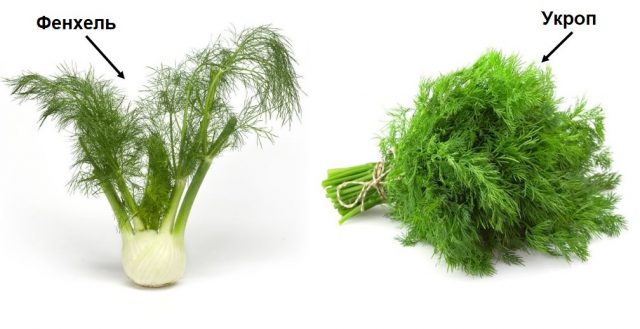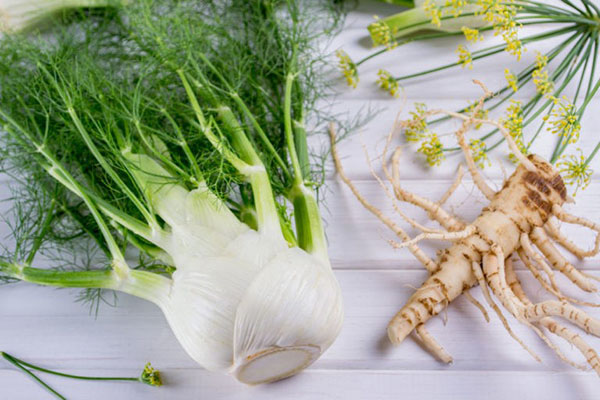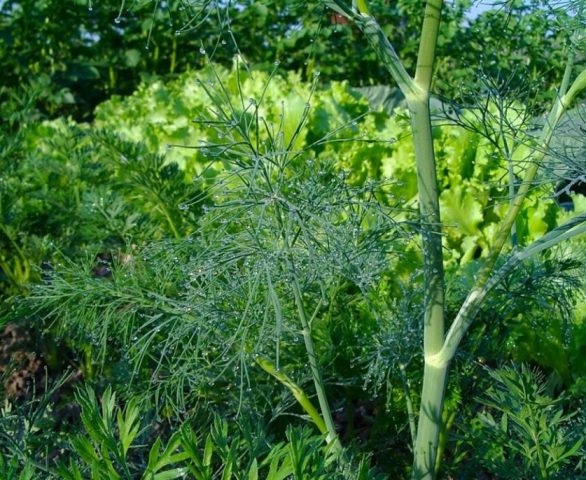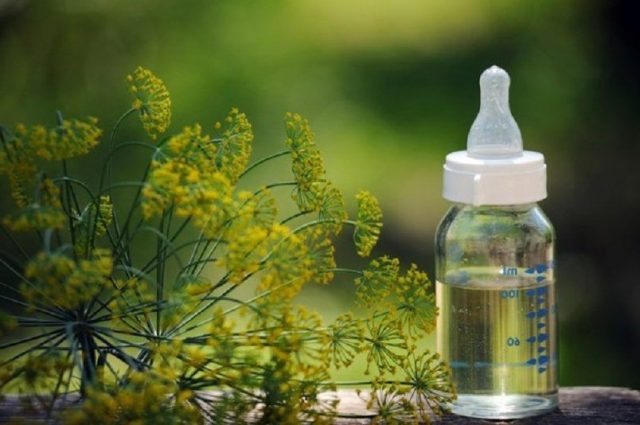Content
Fennel and dill are spicy-aromatic plants, the upper aerial parts of which are very similar in appearance to each other. This is what often misleads many people. They are sure that these are just different names for the same garden culture, but this is not at all the case. Dill and fennel, the difference between which at first glance is not visible, are still different representatives of the Umbrella family. This article will help you understand all the differences.
How fennel differs from ordinary dill in appearance
You can understand the difference between dill and fennel by studying the photo, description and main characteristics of these plants. Most often, these herbs can be easily confused by their appearance when sowing and at an early age. Visually, they are similar in the following ways:
- pinnately dissected leaf shape;
- multiple inflorescences, collected in double umbrellas;
- flowers are yellow;
- the height of adult plants is from 1 to 2 m.
Significant external differences between fennel and dill can be seen upon closer examination of the plants.
Signs | Dill | Fennel |
Bush height | 40-150 cm | 90-200 cm |
Stem
| Straight or slightly branched | Strongly branched. The lower branches are located on petioles |
Leaves | Green in color, sometimes with a bluish tinge | Are located close to each other and push. Have a bluish tint |
Flower shape | Cushion |
|
Root | Slim and long, solid | Fleshy, large |
By the composition and content of vitamins
The leaves, rhizomes and seeds of fennel contain many of these beneficial substances:
- fatty acid;
- vitamins (A, B, D, E and K);
- phytosterols;
- minerals (iron, calcium, copper and manganese).
The main beneficial substances in dill are:
- vitamins (riboflavin - B2, ascorbic acid - C, nicotinic acid - PP);
- essential oils;
- carotene;
- flavonoids;
- mineral salts;
- folic acid;
- trace elements (potassium, zinc, copper, calcium and manganese).
By smell and taste
Fennel and dill have completely different tastes and smells. The difference lies in the fact that the aroma of fennel is pleasant, sweetish, with a slight bitterness and pronounced notes of anise, tarragon and menthol mint. Whereas the smell of dill is easily recognizable, which is difficult to confuse with any other - fresh and rich.
The difference between dill and fennel seeds
The difference between plant seeds is shown in the table:
Seeds | |
Dill | Fennel |
Rounded in shape, small in size (3-5 mm long, 1.5-3 mm wide). They have a characteristic, pronounced aroma. | Elongated, rather large (about 10 mm long, 3 mm wide). Divided into 2 halves. |
Fennel and dill: the difference in growing
Growing difficulties often arise for those gardeners who believe that fennel and dill are one and the same plant. But this is an erroneous opinion, since there is a difference, and each of them has its own varietal characteristics and characteristics.
Fennel is a rather whimsical spice crop.Plants need to create favorable and comfortable conditions. For seed germination, further growth and full development of fennel, it is necessary to provide:
- warmly;
- lime soil;
- abundant and regular watering;
- loosening;
- hilling;
- free space.
Fennel is a thermophilic plant, therefore it is preferable to grow it outdoors in the southern regions. In mid-latitudes, cultivation of this herb in greenhouses or by seedling is recommended.
Dill is a completely unpretentious crop that can grow throughout the garden like a weed. He does not even need a separate bed - the bushes feel comfortable in the aisles of other crops. Dill can grow in shaded areas and will tolerate light frost. A good harvest (even several times per season) can be obtained without using any special agrotechnical methods of care.
How are the beneficial properties of fennel and dill different?
Despite the external similarity, fennel and dill differ in chemical composition. Both plants are used in medicine, but these herbs have different effects on the human body.
Dill has a diuretic effect and has a positive effect on the functioning of the gastrointestinal tract. Herbal infusion promotes:
- increased intestinal motility;
- stimulating the production of gastric juice;
- elimination of flatulence;
- lowering blood pressure;
- increased lactation;
- decrease in increased excitability.
Dill is used in the treatment of diseases:
- cardiovascular system (angina pectoris, arrhythmia, heart failure, hypertension);
- genitourinary system (cystitis, sand and kidney stones);
- nervous system (neuroses, insomnia, depression);
- digestive system (pancreatitis, cramps, lack of appetite);
- dermatological (allergic skin rashes).
Among the main beneficial properties of fennel are expectorant, sedative and antispasmodic effects. The presence in the composition of a large number of active biological components allows the use of this culture for the treatment of diseases:
- Gastrointestinal tract (atony, bloating, constipation, colic in children);
- respiratory system (bronchitis, pneumonia, asthma);
- gallbladder and biliary tract (cholecystitis, inflammation of the bile ducts);
- kidney (stone disease);
- genitourinary system (inflammation of the ureters and urinary tract);
- metabolic (obesity, high cholesterol);
- cutaneous (acne, acne).
The well-known "dill water" is made from fennel seeds, which is considered the most common remedy for combating colic in babies. Its essential oil is one of the main ingredients of the licorice elixir, which has an antitussive effect.
Cooking applications
Fennel is used almost entirely in cooking. Fruits and fresh leaves are eaten as a spicy seasoning - they are added raw to hot first courses and salads. Braised fennel rhizome perfectly complements and emphasizes the taste of fish and meat dishes. Stems and inflorescences (umbrellas) are used for conservation. Fennel oil is added to main dishes, canned vegetables, baked goods (even to bread).
Dill is used in almost all culinary fields. These are first and second courses (hot and cold), appetizers and salads, canned food. In each of these dishes, dill is an irreplaceable ingredient that makes their taste bright and rich. Adding dill seeds to pickles and marinades not only aromas the food, but also prevents spoilage.
Which is better: fennel or dill
Despite the significant difference between dill and fennel, they also have an undeniable similarity - both plants are excellent healers that bring great benefits to the human body. It is difficult to claim with certainty that one herb is much healthier than another. We can only say that fennel and dill should be included in the diet, but in reasonable quantities, like any healthy product.
Conclusion
Fennel and dill - there is a difference between them, and it is quite obvious, therefore, it is necessary to learn how to distinguish these two plants. This will help you to use them correctly both in the preparation of recipes and in treatment. It is easy to grow these useful herbs on your personal plot, the main thing is to take into account their individual agrotechnical characteristics.













